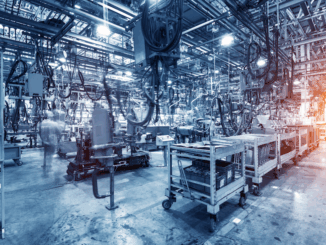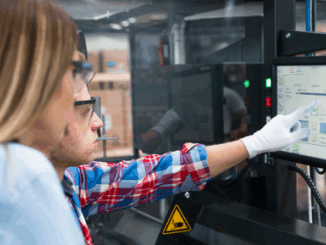August 4, 2025
Built for Speed Backed by Tech: How IT Powers Modern Parts Manufacturing
Parts manufacturing today demands flawless integration: real-time monitoring, predictive reliability, AI-informed decisions, and infrastructure that scales and secures. That’s where good IT comes in.
In today’s parts manufacturing world, speed isn’t optional—it’s survival. Whether you're running CNC machines, high-speed assembly lines, or flexible production cells, it all depends on systems that move fast and stay reliable. Behind the machinery that makes it possible? A properly built IT foundation. And before you say “IT support? Again?”, trust us: modern manufacturing demands nothing less.
Why IT Doesn’t Just Support Manufacturing— it Drives It
Think of your tech stack not as an afterthought but as the engine that powers your whole operation.
Downtime is chaos. According to recent reports, facility downtime can cost manufacturers up to $260,000 per hour (fourjaw.com) and unplanned outages globally exceed $1.4 trillion annually (Business Insider). Worse yet, manual tracking—without real-time automation—can leave you blind to what’s going wrong (machinemetrics.com).
That’s where IT comes in: providing tools—from predictive maintenance systems to real-time dashboards—that keep equipment running, teams informed, and the production line humming. Instead of reacting to breakdowns, you can prevent them.
Real-Time Monitoring: The Heartbeat of Speed
From smart sensors to IIoT integrations, today's machines stream data continuously.
Platforms that connect machinery via OPC-UA, SCADA, and cloud-edge systems feed your technicians live performance metrics. AI-powered tools then analyze temperature spikes, vibration anomalies, or error codes—and flag potential breakdowns before they happen (makula.io).
When manufacturers use intelligent maintenance systems, downtime drops dramatically—often by 30% or more, while service costs also head downward (Wikipedia). That equals more uptime and fewer unplanned headaches.

How IT Powers Modern Parts Manufacturing
MES & Digital Twins: From Reactivity to Productivity
A Manufacturing Execution System (MES) does more than record production—it becomes your control center. It captures data on quality, performance, supply, and scheduling, making production transparent and responsive (Wikipedia).
Meanwhile, digital twins and virtual manufacturing let you simulate production, identify choke points, and optimize layouts before touching real equipment (Wikipedia). That means no trial-and-error attacks, just smart choices and faster implementation.
Companies like BMW report that modeling factory operations virtually can reduce planning time by at least 25% (TIME). That’s efficiency built in front of your eyes.
Lean Techniques, Accelerated by Tech
Speed and precision go hand in hand. Lean methodologies—like SMED or Six Sigma—are widely used in parts manufacturing to reduce changeover times and minimize waste. But without data-powered scheduling, error tracking, and automated notifications, lean theory hits performance walls.
With tech integrated into lean processes, companies cut setup times, improve overall equipment effectiveness (OEE), and reduce scrap rates. There’s no guesswork—just workflows that match your rhythm (netsuite.com).
AI-Maglev Conveyors & Smart Routes: The New Speed Frontier
We’re entering an era where AI-enhanced maglev conveyor systems move parts faster and smoother than conventional belts, cutting energy use and maintenance (arxiv.org). AI routes materials, optimizes pathways, and adapts mid-shift to order changes—all with fewer moving parts.
These systems aren’t pie-in-the-sky—they’re actively redefining fast, flexible manufacturing, with precision output and cost savings that would make last decade’s optimization blush.
Getting the Setup Right: Scalability and Security
Speed doesn’t matter if your network collapses under load. Modern manufacturing demands:
- Scalable cloud or edge infrastructure
- Cybersecurity built into every layer
- Redundancy strategies that keep uptime above 99.9% (itpro.com)
An IT stack that’s built to scale, secure, and support rapid production is worth more than any piece of equipment if you want consistent speed and reliability.
What a Digitally Powered Manufacturing Operation Looks Like
Imagine this real-world scenario: raw stock rolls in. A smart MES schedules a small-batch run, triggers machine tools to recalibrate, and activates maintenance protocols—all within seconds. Sensors track every part of the cycle, AI routes jobs to unused workstations if a line slows down, and data handlers flag defects before they ship.
Your team isn’t firefighting—they’re orchestrating. Your data isn't stale—it’s real-time insight. Your operation isn’t reactive—it’s predictive.Workforce Empowerment Through Tech Integration
It’s not just machines that need support—your workforce does too. In modern parts manufacturing, user-friendly interfaces and centralized dashboards help operators make faster, better decisions. When your team can access real-time job specs, quality thresholds, and maintenance logs at the touch of a screen, mistakes go down and efficiency climbs.
Investing in streamlined user interfaces, mobile access, and digital training tools makes your team more effective—and future-proofs your hiring. Because let’s face it: the next generation of machinists won’t tolerate green screens and floppy disks.
Supply Chain Visibility and Automation
Speed on the shop floor is great—but if your supply chain is slow or opaque, that speed gets canceled out. Manufacturers are increasingly turning to integrated ERP systems and supply chain visibility tools to close the gap between planning and production.
With real-time updates on parts availability, shipment tracking, and inventory status, you can avoid last-minute surprises. Automated restocking, barcode scanning, and vendor alerts reduce manual errors and ensure your lines keep running—without human bottlenecks.
And when the global supply chain hiccups again (because it will), you’ll be the one who saw it coming and planned around it.
Compliance and Traceability Made Easy
In many industries, parts manufacturing comes with a side of regulation—automotive, aerospace, medical devices, you name it. Proving compliance and maintaining traceability used to be a paper-heavy nightmare.
Today? IT systems do the heavy lifting. Digital audit trails, automated report generation, and traceable production histories let you meet regulatory demands without slowing down operations. From ISO certifications to FDA mandates, your tech stack should help you comply with ease.
Having systems in place that support full traceability also protects you during recalls, disputes, or quality control surprises. It’s not just a CYA move—it’s smart business.
Fly Consulting builds that operation—not in theory, but in code, wiring, and dashboards—all tailored to your parts plant and your speed goals.

How IT Powers Modern Parts Manufacturing
Bottom Line: Speed Needs Tech That Can Keep Up
Let’s wrap it up:
- Speed with no visibility isn't sustainable
- Tech with no reliability isn’t usable
- Smart infrastructure built for speed? That’s your competitive edge
Parts manufacturing today demands flawless integration: real-time monitoring, predictive reliability, AI-informed decisions, and infrastructure that scales and secures.
If your production line demands speed, dependability, and modern IT muscle—that's our lane. Fly Consulting builds IT stacks that do more than support: they power.
Ready to move fast and stay fast? Let’s talk.
IT EDUCATION
Empower Your Organization with IT Insights: Don't Miss Our Blog!



